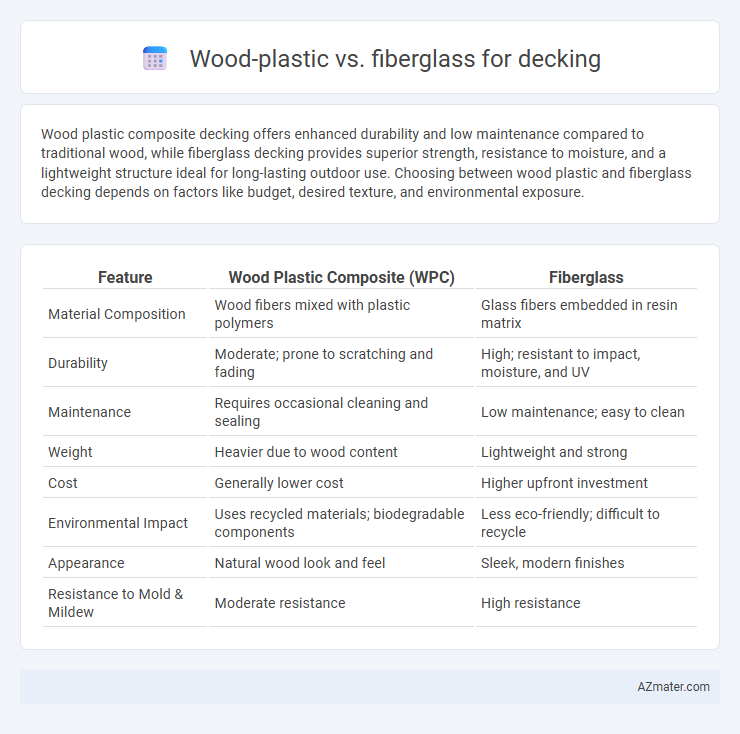Wood plastic composite decking offers enhanced durability and low maintenance compared to traditional wood, while fiberglass decking provides superior strength, resistance to moisture, and a lightweight structure ideal for long-lasting outdoor use. Choosing between wood plastic and fiberglass decking depends on factors like budget, desired texture, and environmental exposure.
Table of Comparison
| Feature | Wood Plastic Composite (WPC) | Fiberglass |
|---|---|---|
| Material Composition | Wood fibers mixed with plastic polymers | Glass fibers embedded in resin matrix |
| Durability | Moderate; prone to scratching and fading | High; resistant to impact, moisture, and UV |
| Maintenance | Requires occasional cleaning and sealing | Low maintenance; easy to clean |
| Weight | Heavier due to wood content | Lightweight and strong |
| Cost | Generally lower cost | Higher upfront investment |
| Environmental Impact | Uses recycled materials; biodegradable components | Less eco-friendly; difficult to recycle |
| Appearance | Natural wood look and feel | Sleek, modern finishes |
| Resistance to Mold & Mildew | Moderate resistance | High resistance |
Understanding Wood Plastic and Fiberglass Decking
Wood plastic composite decking blends wood fibers and recycled plastics to create a durable, low-maintenance material resistant to rot and insects. Fiberglass decking consists of a strong, lightweight composite reinforced with glass fibers, offering high strength, resistance to moisture, and minimal expansion or contraction. Both options provide eco-friendly, long-lasting alternatives to traditional wood, with wood plastic emphasizing natural aesthetics and fiberglass excelling in structural performance and weather resistance.
Material Composition: Wood Plastic vs Fiberglass
Wood plastic composite decking consists of a blend of wood fibers and recycled plastic, offering a balance of natural aesthetics and durability with resistance to rot and insect damage. Fiberglass decking is made from glass fibers embedded in a resin matrix, resulting in a highly durable, lightweight, and low-maintenance material with superior strength and resistance to moisture. The choice between wood plastic and fiberglass depends on factors like desired texture, maintenance levels, and longevity requirements.
Durability and Longevity Comparison
Wood plastic composite decking offers excellent resistance to moisture, rot, and insect damage, making it highly durable for outdoor use, with an average lifespan of 25-30 years. Fiberglass decking, composed of reinforced resin, provides superior strength and longevity, often exceeding 30-40 years with minimal maintenance due to its non-porous surface and UV resistance. Both materials outperform traditional wood decking in durability, but fiberglass holds a distinct advantage in longevity and resistance to weathering and structural fatigue.
Maintenance Requirements for Each Material
Wood plastic composite decking requires minimal maintenance, mainly involving periodic cleaning with soap and water to prevent mold and dirt buildup, and it resists rot, insects, and fading. Fiberglass decking also demands low upkeep, with occasional washing needed to remove debris and prevent algae growth, and it excels in durability against moisture, corrosion, and UV damage. Both materials eliminate the need for staining or sealing, but fiberglass offers superior resistance to cracking and warping under diverse weather conditions.
Aesthetics and Design Flexibility
Wood plastic composite decking offers a natural wood appearance combined with enhanced durability and a variety of colors and textures that mimic hardwood grains, providing versatile design options. Fiberglass decking boasts a sleek, smooth finish and greater design flexibility with customizable shapes, colors, and patterns, ideal for modern or intricate deck layouts. Both materials support diverse aesthetics, but fiberglass excels in contemporary applications while wood plastic composites suit traditional or rustic styles.
Cost Analysis: Initial and Long-Term Expenses
Wood plastic composite decking typically has a higher initial cost than fiberglass, with prices ranging from $4 to $8 per square foot compared to fiberglass's $3 to $6 per square foot. Long-term expenses favor fiberglass due to its superior durability, resistance to rot, and minimal maintenance requirements, reducing costs on repairs and replacements. Wood plastic composites may incur additional maintenance costs such as staining or sealing every few years, impacting their overall lifetime expense.
Environmental Impact and Sustainability
Wood plastic composite decking combines recycled wood fibers and plastic, offering a sustainable option by diverting waste from landfills and reducing reliance on virgin materials. Fiberglass decking, made primarily from glass fibers and resins, boasts durability and long lifespan, but its production involves high energy consumption and limited recyclability. Choosing wood plastic composites can lower environmental impact through use of recycled content and biodegradability potential, while fiberglass excels in longevity but poses challenges in end-of-life disposal and resource intensity.
Installation Process and Complexity
Wood plastic composite decking typically offers easier installation due to its uniformity and pre-fabricated design, allowing for straightforward cutting and fastening with standard tools. Fiberglass decking requires more specialized handling and tools because of its rigid and composite nature, often necessitating precise measurements and careful drilling to avoid damage. Installation complexity for fiberglass is generally higher, with longer time requirements and potential for increased labor costs compared to wood plastic composites.
Slip Resistance and Safety Features
Wood plastic composite decking typically offers better slip resistance due to its textured surface and integrated additives that enhance grip, making it a safer option in wet conditions. Fiberglass decking, while lightweight and strong, often has a smoother surface that can become slippery when wet unless treated with anti-slip coatings. Selecting decking materials with certified slip resistance ratings and safety features like anti-slip strips or coatings is essential to minimize accident risks.
Which Decking Material is Best for Your Needs?
Wood plastic composite (WPC) decking offers superior resistance to rot, insect damage, and requires less maintenance compared to fiberglass, making it ideal for homeowners seeking durability with minimal upkeep. Fiberglass decking excels in strength-to-weight ratio and resists fading, cracking, and mold, fitting perfectly for areas with extreme weather conditions or heavy foot traffic. Choosing the best decking material depends on budget, aesthetic preference, and the environmental exposure of your outdoor space.

Infographic: Wood plastic vs Fiberglass for Decking
 azmater.com
azmater.com